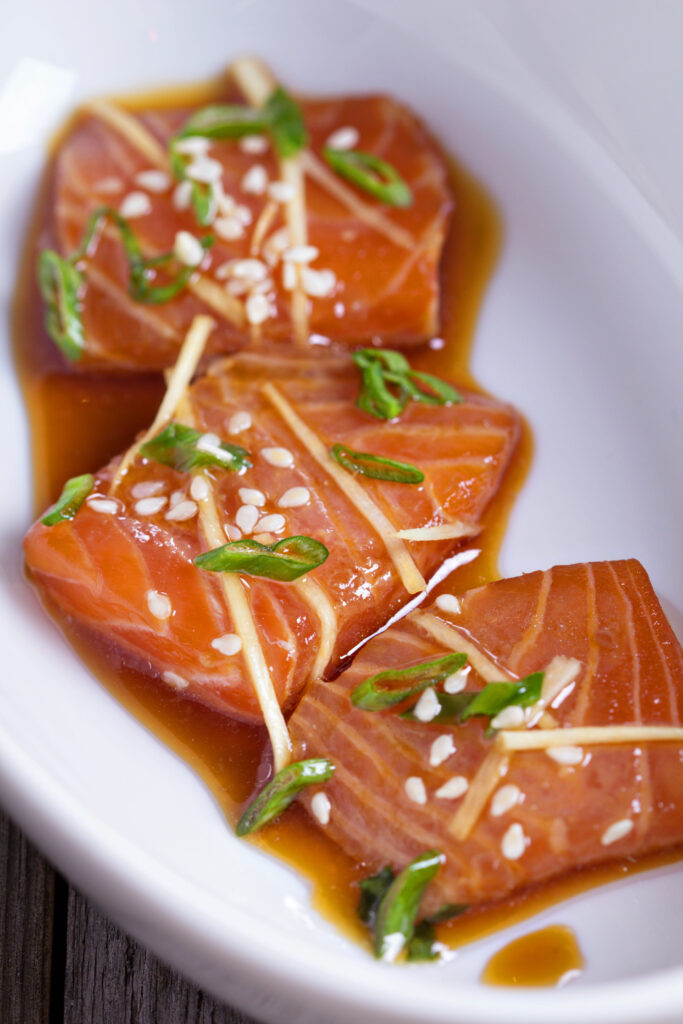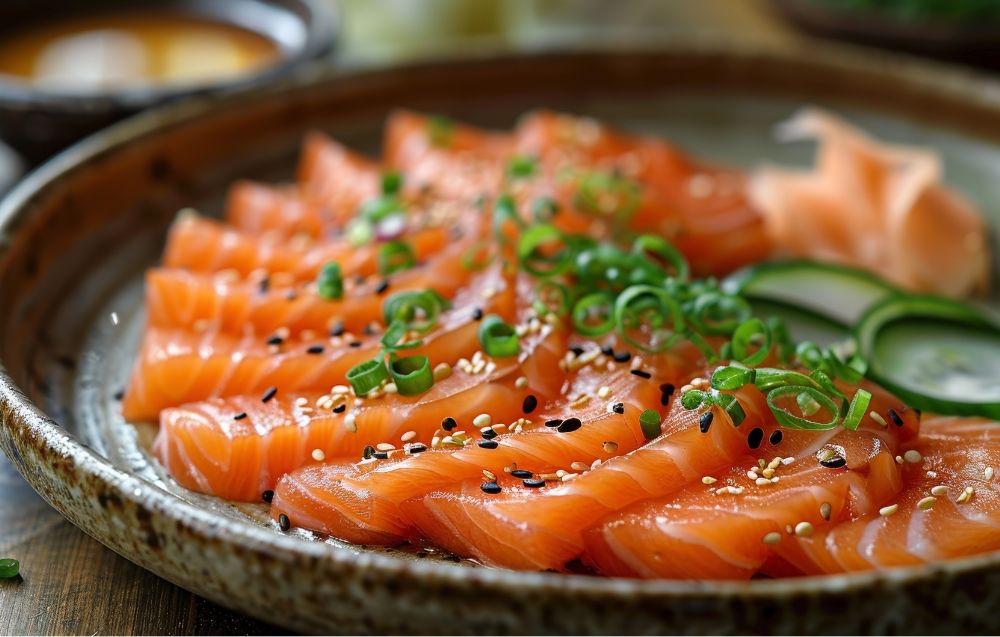Salmon sashimi – just the name sounds fancy, doesn’t it? It conjures up images of delicate slices of fresh, buttery salmon arranged artfully on a plate. If you’ve ever wondered what makes this dish so special or how to enjoy it to the fullest, you’re in the right place. In this guide, we’ll dive deep into the world of salmon sashimi, covering its history, health benefits, and much more. Ready to dive in? Let’s go!
Explore pink salmon recipes to see how salmon can be transformed into quick, energizing dishes.
What is Salmon Sashimi?
If you’re new to the sashimi game, you might be scratching your head. So, what exactly is salmon sashimi? Simply put, it’s thinly sliced raw salmon, served as a delicacy in Japanese cuisine. Unlike sushi, sashimi is all about enjoying the fish itself without distractions like rice or seaweed.
Curious about salmon alternatives? Learn about frozen salmon cooking tips for quick and easy preparation.

The Origins of Sashimi
Sashimi has a rich history rooted in Japan, where it was originally created as a way to enjoy the freshest catches from the sea. The word “sashimi” translates to “pierced body,” referring to the traditional practice of slicing fish into precise, bite-sized pieces. Salmon, however, wasn’t always the top choice. It wasn’t until Norwegian salmon became popular in Japan during the 1980s that salmon sashimi truly took off.
“Salmon sashimi wasn’t an immediate favorite in Japan. It took innovation and a bit of marketing magic to turn it into the beloved dish we know today.”
Key Characteristics of Salmon Sashimi
What makes salmon sashimi stand out from other types of sashimi? First, there’s the vibrant color. The rich orange hue of salmon, marbled with white fat, is visually stunning. Then there’s the texture – smooth, silky, and slightly firm. Finally, the taste: fresh salmon sashimi has a mild, buttery flavor that melts in your mouth. It’s sushi-grade fish at its best.
Dive deeper into cooking techniques by exploring the air fryer salmon guide for healthier alternatives.
Types of Salmon Used in Sashimi
Not all salmon is created equal. When it comes to sashimi, the type of salmon you choose can make or break your experience. Let’s explore the most popular options.
Atlantic Salmon
Atlantic salmon is one of the most common types used for sashimi. It’s farmed extensively, making it widely available and relatively affordable. Its rich, fatty texture and mild flavor make it a crowd-pleaser.
Interested in different preparation methods? Check out how to bake salmon at 350°F for perfectly cooked results.
Sockeye Salmon
Looking for something a bit leaner? Sockeye salmon might be your jam. This wild-caught variety has a deep red color and a more robust flavor, making it ideal for those who prefer their sashimi with a little extra personality.
King Salmon
True to its name, king salmon (also known as Chinook) is the king of the sashimi world. With a buttery, melt-in-your-mouth texture and a slightly sweet taste, it’s often considered the best salmon for sashimi. It’s pricier than other varieties but worth every penny for special occasions.
If you’re craving more seafood insights, explore colossal shrimp recipes for inspiration.
Health Benefits of Salmon Sashimi
Why do people go wild for salmon sashimi? Beyond the taste, it’s packed with nutrients that do wonders for your body. Let’s break it down.
Rich in Omega-3 Fatty Acids
You’ve probably heard of omega-3s, the “good fats” your body loves. Salmon sashimi is a powerhouse of these fatty acids, which are great for your heart, brain, and joints. Plus, they can help reduce inflammation – a win-win for anyone looking to stay healthy.
High Protein Content
Protein is the building block of life, and salmon sashimi delivers it in spades. Each bite is a protein-packed punch, making it an excellent choice for those looking to build muscle or stay full longer.
Packed with Essential Vitamins and Minerals
Salmon sashimi isn’t just about fats and protein. It’s also loaded with essential vitamins like B12 and D, as well as minerals like selenium and potassium. These nutrients are key to maintaining healthy skin, strong bones, and a robust immune system.
Common Problems with Salmon Sashimi
Of course, not everything is smooth sailing in the world of sashimi. There are a few common problems that can trip up even seasoned sashimi lovers.
Identifying Freshness
Freshness is everything when it comes to sashimi. The last thing you want is fish that’s been sitting around for too long. But how can you tell if salmon is fresh? Look for vibrant color, a clean scent, and firm texture. If it smells fishy or looks dull, steer clear!
Concerns About Parasites
Eating raw fish comes with risks, and parasites are one of the main culprits. Wild salmon, in particular, is more likely to carry parasites than farmed salmon. This can be a major concern for people who aren’t familiar with how to handle raw fish safely.
Cross-Contamination in Preparation
If you’re preparing salmon sashimi at home, cross-contamination is a real risk. Using the same cutting board or knife for raw fish and other foods can lead to bacteria spreading – and nobody wants that.
Solutions to Common Problems
Don’t let these challenges scare you away from enjoying salmon sashimi. With a few simple precautions, you can savor this dish without worry.
How to Ensure Freshness
When buying salmon, always check the sell-by date and opt for sushi-grade fish. If possible, purchase from a reputable fishmonger who understands the importance of freshness. Once you have your salmon, keep it refrigerated until you’re ready to use it.
Parasite Prevention Techniques
Worried about parasites? Choose farmed salmon over wild, as it’s less likely to carry parasites. Alternatively, freezing the fish at a very low temperature (-4°F/-20°C or below) for at least seven days can kill any potential parasites.
For more insights on safe seafood preparation, visit the frozen fish guide.
“When in doubt, freeze it out! Proper freezing can give you peace of mind when enjoying sashimi.”
Proper Food Safety Practices
To avoid cross-contamination, dedicate specific tools for raw fish preparation. Use separate cutting boards, knives, and even towels to ensure you’re not spreading bacteria around your kitchen.
How to Choose the Best Salmon for Sashimi
When it comes to making or enjoying salmon sashimi, choosing the right fish is half the battle. The quality of your salmon directly impacts the flavor, texture, and overall experience. But how do you ensure you’re picking the best salmon for sashimi? Let’s dive in!
Sourcing High-Quality Salmon
Not all salmon you find at the store is suitable for sashimi. Look for fish labeled “sushi-grade” or “sashimi-grade.” This label doesn’t mean the fish is fresher than others—it indicates that it’s been handled and frozen in a way that minimizes the risk of parasites. Trusted seafood markets or specialty stores are your best bet for finding high-quality fish.
When in doubt, ask questions! Don’t be shy about asking your fishmonger where the salmon is sourced, whether it’s wild or farmed, and how it’s been handled. A knowledgeable seller is often a sign you’re in the right place.
Recognizing Fresh and Safe Cuts
So you’ve found a reputable source—great! Now, let’s talk about what to look for when inspecting the salmon itself. Here’s a quick checklist:
- Color: Look for vibrant, rich orange or red flesh with white marbling. Avoid dull, grayish hues.
- Texture: The fish should feel firm and springy to the touch. If it’s mushy, it’s a no-go.
- Smell: Fresh salmon should have a clean, mild scent. If it smells overly fishy, it’s likely past its prime.
- Moisture: The surface should appear moist but not slimy. Slime is a sign of spoilage.
Proper preparation starts with knowing the nutritional benefits and risks of raw fish. Learn more about the nutritional value of raw fish to make informed choices.
“Trust your senses! Freshness is something you can see, feel, and smell.”
Preparing Salmon Sashimi at Home
There’s something incredibly rewarding about making salmon sashimi in your own kitchen. It’s not just a meal—it’s an experience. Let’s walk through everything you need to know to prepare restaurant-quality salmon sashimi at home.
Tools You Need for Preparation
Before you start slicing away, make sure you’ve got the right tools. Here’s a list of essentials:
- Sharp Knife: A Japanese sashimi knife (yanagiba) is ideal, but any long, sharp knife will do. A dull blade can ruin the texture.
- Cutting Board: Use a clean, sturdy cutting board. Consider dedicating one solely to raw fish to prevent cross-contamination.
- Tweezers: Pin bone tweezers are a must for removing any stray bones.
- Paper Towels: These help pat the fish dry and remove excess moisture.
Step-by-Step Guide to Making Salmon Sashimi
- Chill the Salmon: Keep your fish in the fridge until the moment you’re ready to prepare it. Cold salmon is easier to slice and holds its shape better.
- Inspect and Trim: Lay the salmon on a clean surface and inspect it for bones. Use tweezers to pull out any you find. Trim off the skin and any discolored sections.
- Pat Dry: Gently pat the salmon dry with paper towels to remove moisture.
- Slice with Precision: Use long, even strokes to cut the salmon into thin slices. Aim for about ¼-inch thickness for the perfect bite.
- Plate Like a Pro: Arrange your sashimi slices neatly on a chilled plate. Garnish with daikon radish, shiso leaves, or edible flowers for a touch of elegance.
Pairing and Serving Ideas for Salmon Sashimi
Salmon sashimi is amazing on its own, but pairing it with the right sauces, sides, and drinks can elevate the experience to new heights. Let’s explore some pairing and serving ideas that’ll make your sashimi shine.
Best Sauces and Condiments
- Soy Sauce: A classic choice, soy sauce enhances the umami of the salmon without overpowering its natural flavor.
- Wasabi: Add a small dab of wasabi for a spicy kick. Be careful not to overdo it!
- Ponzu Sauce: This tangy mix of soy sauce and citrus juice adds a refreshing twist.
- Ginger: Pickled ginger (gari) cleanses your palate between bites, allowing you to savor each piece.
Complementary Side Dishes
Looking to make your sashimi meal more filling? Here are a few sides that pair beautifully with salmon sashimi:
- Miso Soup: A warm, comforting soup that balances the coolness of the sashimi.
- Seaweed Salad: The crunch and umami of seaweed provide a lovely contrast to the soft salmon.
- Steamed Edamame: Lightly salted edamame is a simple, healthy snack that complements the flavors of sashimi.
For an authentic touch, consider learning about Japanese dining etiquette to fully immerse yourself in the cultural experience.
“Think of side dishes as the supporting cast to the sashimi’s starring role.”
Popular Variations of Salmon Sashimi
Variety is the spice of life, and salmon sashimi is no exception. Let’s explore some creative ways to enjoy this beloved dish.
Salmon Nigiri
Want to add a little rice to the mix? Salmon nigiri combines sashimi with bite-sized balls of seasoned rice. It’s a great option if you’re looking for something more filling while still enjoying the fresh flavors of sashimi.
Salmon Sashimi Salad
This variation adds a healthy twist by pairing salmon sashimi with mixed greens, avocado, and a tangy sesame dressing. It’s light, refreshing, and perfect for lunch.
Spicy Salmon Sashimi
For those who love a bit of heat, spicy salmon sashimi is the way to go. Toss the salmon slices in a mix of chili oil, sesame oil, and finely chopped green onions for an extra kick.
Nutritional Comparison: Sashimi vs. Cooked Salmon
Salmon is celebrated for its incredible nutritional profile, whether it’s served raw or cooked. But did you know the preparation method can influence its nutrient content? Let’s break down how salmon stacks up against its cooked counterpart.
Nutritional Differences
When you eat salmon sashimi, you’re enjoying the fish in its purest form. Raw salmon retains all of its natural nutrients, especially heat-sensitive vitamins like vitamin C and certain B vitamins, which can diminish during cooking. Sashimi also boasts higher moisture content, giving it that silky, melt-in-your-mouth texture.
On the other hand, cooked salmon has its perks too. Cooking enhances the availability of certain nutrients, like antioxidants, and can reduce the fat content depending on the cooking method. However, grilling or frying may add extra calories through oils or seasonings.
Taste and Texture Contrasts
Let’s talk about the eating experience. Sashimi offers a delicate, buttery texture and a clean, subtle taste that highlights the natural flavor of salmon. Cooked salmon, depending on the method, develops a firmer texture and more pronounced flavors due to caramelization or seasoning.
“Sashimi is like a whisper of the ocean, while cooked salmon is a bold declaration of flavor.”
Salmon Sashimi in Culinary Culture
Salmon sashimi is more than just a dish—it’s a cultural phenomenon that’s woven into the culinary traditions of Japan and beyond. Let’s explore its roots and growing global popularity.
Role in Japanese Cuisine
In Japan, sashimi is revered as an art form. It’s not just about serving raw fish—it’s about honoring the ingredients, showcasing their freshness, and presenting them with elegance. Traditionally, sashimi is enjoyed as the opening course in a formal Japanese meal, setting the stage for the feast to come.
Did you know that sashimi preparation is a skill chefs spend years perfecting? Every cut is intentional, designed to highlight the texture and flavor of the fish.
Growing Popularity Worldwide
What started as a Japanese delicacy has now become a global sensation. From trendy sushi bars in New York to fine dining restaurants in Paris, salmon sashimi has found its way into the hearts (and stomachs) of food lovers everywhere. Its appeal lies in its simplicity, health benefits, and, of course, Instagram-worthy presentation.
FAQs About Salmon Sashimi
Salmon sashimi is beloved, but it comes with its fair share of questions. Let’s tackle some of the most common ones.
Is it Safe to Eat Raw Salmon?
Yes, but with precautions. Salmon sashimi is safe as long as you’re using sushi-grade fish, which has been frozen to kill parasites. Always buy from a trusted source and consume it as fresh as possible.
How Can I Tell if Salmon is Sushi-Grade?
Sushi-grade salmon is typically labeled as such and sold at specialty seafood markets or reputable stores. If in doubt, ask your fishmonger. Sushi-grade fish is handled and frozen in a way that ensures its safety for raw consumption.
Can I Use Wild-Caught Salmon for Sashimi?
Yes, but be cautious. Wild-caught salmon is more likely to carry parasites than farmed salmon. If you’re using wild salmon, make sure it has been properly frozen before using it for sashimi.
Conclusion: Enjoying Salmon Sashimi Safely
Salmon sashimi is more than just a meal—it’s an experience that connects you to the freshness of the ocean and the artistry of Japanese cuisine. Whether you’re enjoying it at a high-end sushi restaurant or slicing it up at home, the key is to focus on quality and safety.
So, the next time you’re in the mood for something light, nutritious, and utterly delicious, remember: This salmon is always a good idea. Just make sure to source it responsibly, prepare it with care, and savor every bite.
“Salmon sashimi isn’t just food—it’s a celebration of simplicity, flavor, and craftsmanship.”

